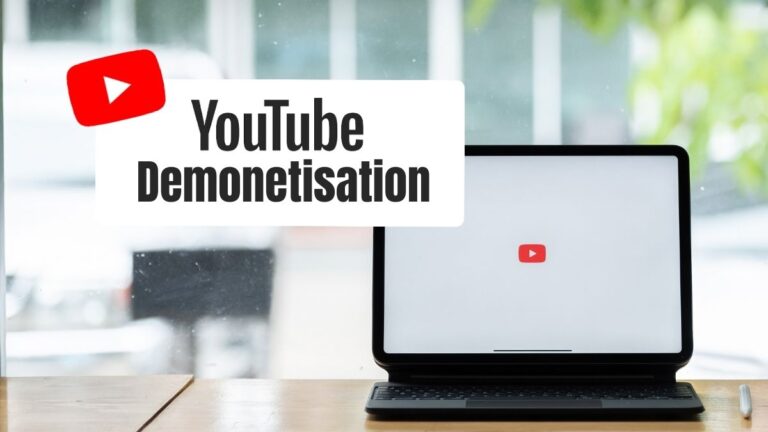YouTube has evolved as a strong platform for creators to display their skills, exchange information, and interact with audiences all over the world. In the enormous universe of online content production, YouTube has emerged as a powerful platform. However, with the chances for creation and interaction, there exists a notion known as demonetization on YouTube. This has caused both anxiety and controversy among the community of creators. We go into the complexities of YouTube’s demonetization. Its repercussions, and what content producers need know to handle this facet of the digital environment in this detailed guide.
Comprehension of the Demonetization of YouTube
Demonetization on YouTube is the process by which videos uploaded by a creator are determined to be unsuitable for the purpose of earning money. This is done via advertising on the platform. Because of this, advertisements will not be shown on the video. And the video’s authors will not get payment for views or clicks on advertisements. Demonetization may take place for a variety of reasons. Including the presence of material that does not comply with the criteria designed to attract advertisers to YouTube.
A Look at the Factors That Affect YouTube Demonetisation
The sensitivity of the content is one of the most important variables that contributes to demonetization. To ensure that users and advertisers are able to interact in a manner that is safe and courteous, YouTube has implemented community standards and content rules that cater to the needs of advertising. Videos that include material that is deemed to be contentious, obscene, or sensitive might be marked for demonetization.
Copyright issues are another potential contributor to a decline in monetary value. Videos that utilize copyrighted content without the appropriate license or without following the guidelines for fair use risk having their monetization disabled. This consists of audio tracks, still photos, and short video segments.
Videos that breach YouTube’s regulations, such as those that promote harassment, hazardous conduct, or speech that is hateful, are at risk of having their monetization disabled. In addition, material that has deceptive names, thumbnails, or descriptions that are meant to generate clicks but do not provide the content that was promised may also be liable to having its monetization disabled.
Consequences of the YouTube Demonetisation of the Currency
The demonetization of material has far-reaching ramifications for the authors of such content. To start, there is an immediate effect on one’s finances. The demonetization of creators’ work has a huge impact on their prospective revenue. Demonetization might result in a precarious financial situation for many content producers. This is because advertising revenue is a significant source of income for many.
In addition to the potential financial repercussions, demonetization may also have an impact on the exposure and marketing of a video. Videos that have been demonetized have a lower chance of being pushed by YouTube’s algorithm. This may have an effect on both the reach and discoverability of a video.
Take Charge Of Your Content Creation With Exly!
In addition, videos that have had their monetization disabled will no longer have access to monetization tools. Such as Super Chat, Channel Memberships, or money from YouTube Premium. These features have the potential to bring in new revenue sources and increase the level of viewer engagement.
Managing the Process of YouTube Demonetisation
There are a few different approaches that content providers might use in order to successfully handle the hurdles posed by demonetization. It is very necessary for you to get familiar with the community rules and content regulations that are available on YouTube. You may drastically lower the likelihood of having your material demonetized. You can do so by checking to see that it complies with these standards.
Another successful strategy is the production of material that is both unique and of high quality. Originality not only lowers the likelihood that there will be issues with copyright, but it also increases the value that you bring to the attention of your audience.
It is very necessary to keep your titles, descriptions, and images as transparent as possible. When you include metadata that is true and clear, you guarantee that viewers are aware of what to anticipate from your videos. This lowers the risk of having your films demonetized due to clickbait.
It is essential to thoroughly investigate the rationale offered by YouTube in the event that one of your videos loses its monetization status. Strategies that may be useful include making the appropriate revisions to your material. And appealing the judgment if you think it was made in mistake.
In addition to this, a sensible strategy is to diversify one’s sources of earnings. Given the possibility of demonetization, putting all of your eggs in the advertising income basket might be a hazardous move. The investigation of other revenue sources, such as sponsorships, goods sales, crowdsourcing, and affiliate marketing, may serve as a safety net. And help to the development of a model of income that is more sustainable.
The final word
YouTube Demonetisation: The demonetization of YouTube is an issue that every content producer should be aware of as they work toward developing a significant presence online. To construct a presence on the platform that is both sustainable and profitable in the long run. It is crucial to first have an understanding of the variables that lead to demonetization. Its effects on profits and visibility, and the best practices that can be used to traverse this problem. Creators who keep themselves updated, adjust their methods. And put audience engagement and content quality at the forefront of their priorities will continue to prosper on YouTube.





